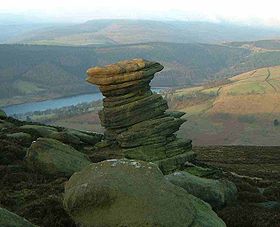Derwent Edge
| Derwent Edge | |
|---|---|

The Salt Cellar with Ladybower Reservoir in the Background
|
|
| Highest point | |
| Elevation | 538 m (1,765 ft) (Back Tor) |
| Prominence | 67 m |
| Listing | TuMP |
| Coordinates | 53°24′55″N 1°42′15″W / 53.4152°N 1.7041°W (Back Tor) |
| Geography | |
| Location | Derbyshire, England |
| Parent range | Peak District |
| OS grid | SK197909 |
| Topo map | OS Landranger 110 |
Derwent Edge is a Millstone Grit escarpment that lies above the Upper Derwent Valley in the Peak District National Park in the English county of Derbyshire. An Ordnance Survey column marks the highest point of the Edge at Back Tor (538 metres, 1765 feet). North of Back Tor the edge extends into Howden Edge and enters the county of South Yorkshire.
The Millstone Grit forms the edge of the high peat moorland plateau on the eastern side of the valley above Ladybower Reservoir, the edges being the last remains of the gritstone which originally covered all of the Peak District, most of which was scraped off by glaciers in the last ice age.
The Edge itself is notable for its unusual gritstone tors and its views of the Derwent Valley and the Dark Peak landscape; these features along with its proximity to Sheffield have made it a popular venue for walkers. Its popularity has led to substantial path erosion and the most affected parts of the edge between The Salt Cellar and Lost Lad Hillend have been paved with natural stone slabs to reduce further damage as part of the Lottery Paths Project.
Derwent Edge has several examples of unusually shaped gritstone tors which have been formed by the actions of wind, rain and frost over many centuries. These tors have been named over the years by local residents and have now been officially titled on Ordnance Survey maps. These include the Cakes of Bread, the Coach and Horses and the Salt Cellar. The Coach and Horses (also known as the Wheel Stones and thus named on Ordnance Survey maps) resembles a coach and horses on the horizon when viewed from the A57 road to the south. Lost Lad Hillend is worth visiting as it has a stone built topographic indicator to aid identifying landmarks in the extensive view.
...
Wikipedia
